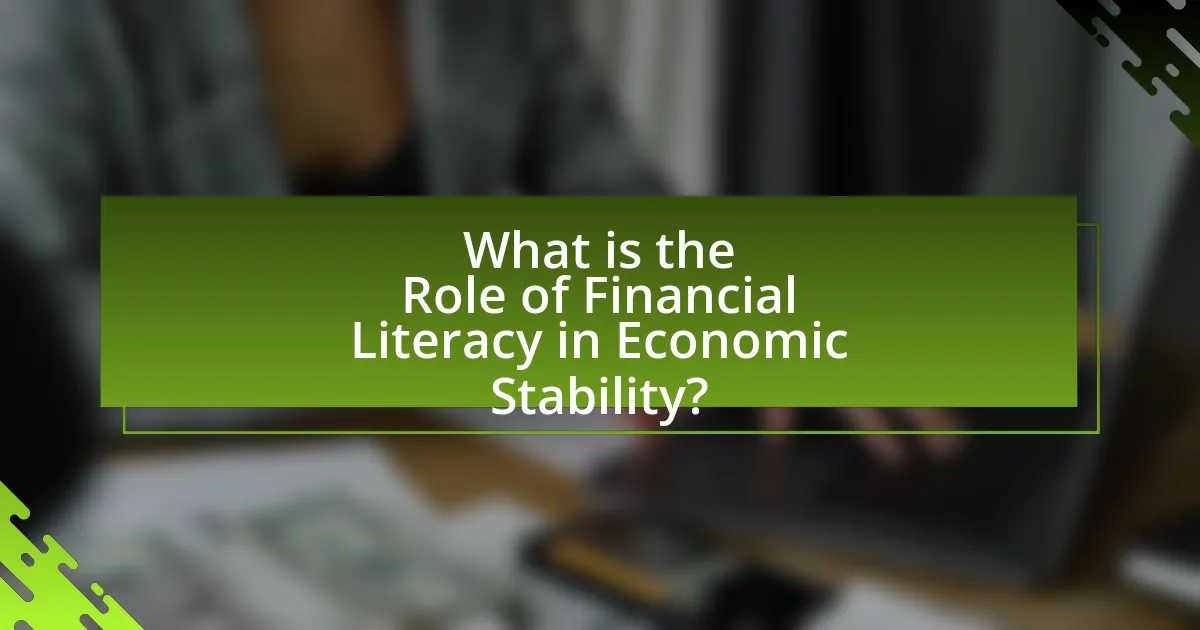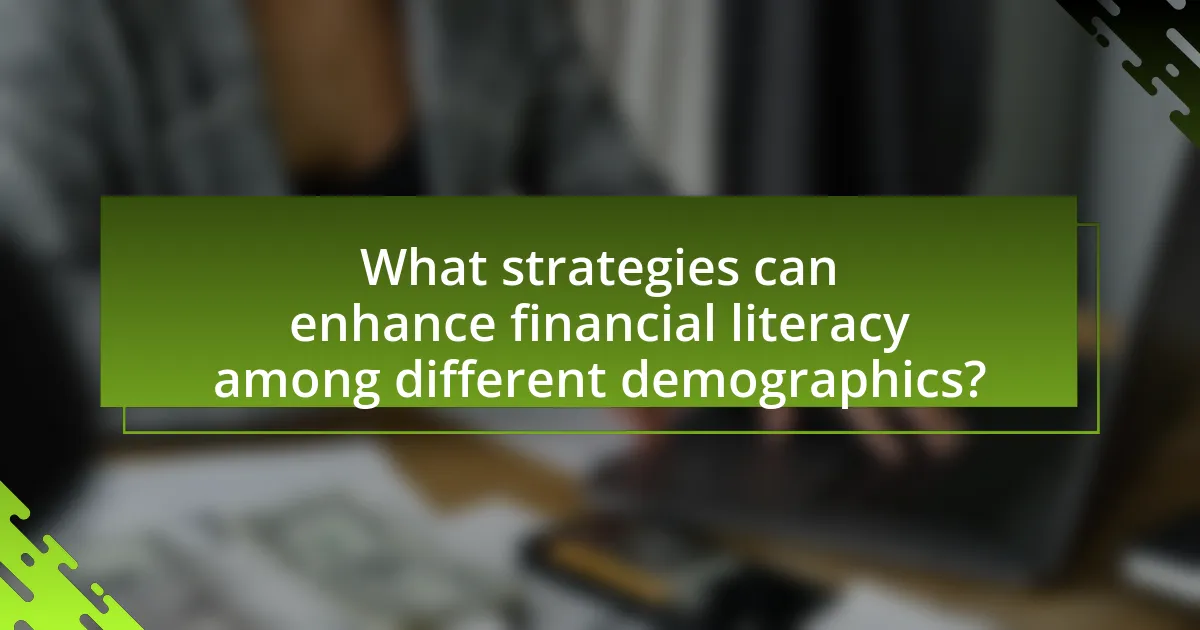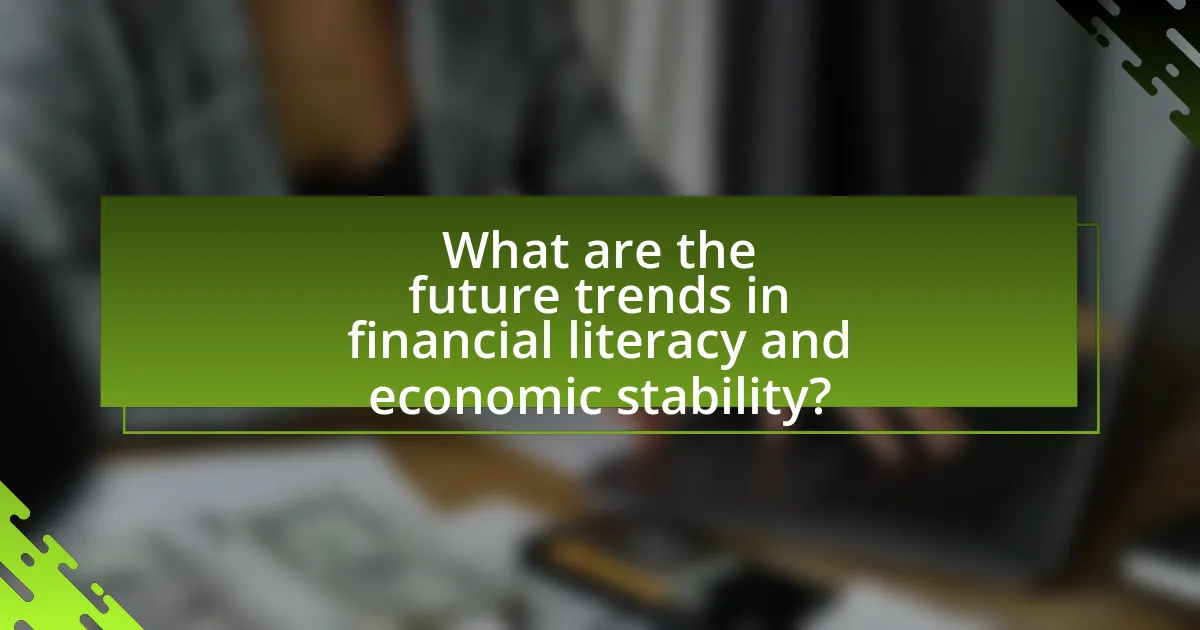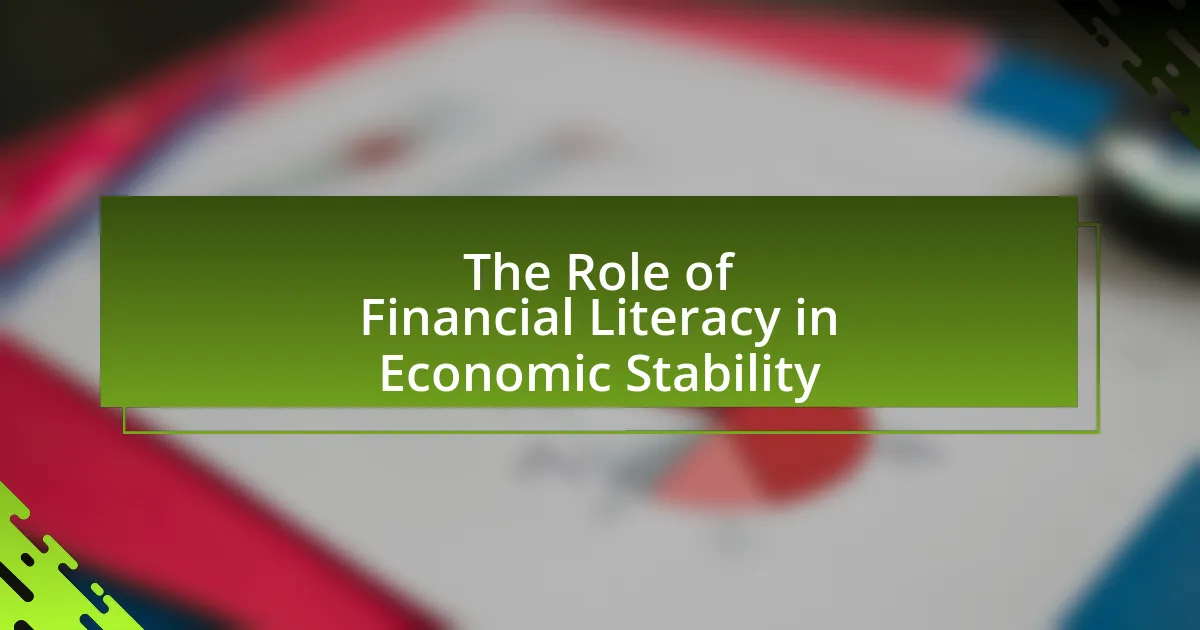Financial literacy is defined as the knowledge and skills that enable individuals to make informed financial decisions, which is essential for economic stability. The article explores the significant impact of financial literacy on individual decision-making, community development, and national economies. Key components such as budgeting, saving, investing, and understanding credit are discussed, highlighting their influence on personal financial management and poverty reduction. Additionally, the article addresses the challenges in promoting financial literacy and outlines strategies for enhancing financial education across various demographics, emphasizing the role of technology and community organizations in fostering a financially literate population.

What is the Role of Financial Literacy in Economic Stability?
Financial literacy plays a crucial role in economic stability by equipping individuals with the knowledge and skills necessary to make informed financial decisions. When people understand concepts such as budgeting, saving, investing, and managing debt, they are more likely to engage in behaviors that promote financial health, which in turn contributes to overall economic stability. For instance, a study by the National Endowment for Financial Education found that individuals with higher financial literacy are less likely to experience financial crises, leading to reduced reliance on social safety nets and fostering a more resilient economy. Additionally, communities with higher levels of financial literacy tend to have lower rates of poverty and unemployment, further supporting economic stability.
How does financial literacy impact individual financial decision-making?
Financial literacy significantly enhances individual financial decision-making by equipping individuals with the knowledge and skills necessary to make informed choices about budgeting, saving, investing, and managing debt. Research indicates that individuals with higher financial literacy are more likely to engage in positive financial behaviors, such as creating budgets and saving for emergencies. For instance, a study by Lusardi and Mitchell (2014) found that financially literate individuals are 50% more likely to plan for retirement compared to those with low financial literacy. This correlation suggests that financial literacy directly influences the ability to make sound financial decisions, ultimately contributing to greater economic stability for individuals and communities.
What are the key components of financial literacy?
The key components of financial literacy include budgeting, saving, investing, understanding credit, and financial planning. Budgeting enables individuals to track income and expenses, ensuring they live within their means. Saving emphasizes the importance of setting aside funds for emergencies and future goals, with studies showing that individuals with savings are better prepared for financial shocks. Investing involves understanding various asset classes and the risks associated with them, which can lead to wealth accumulation over time. Understanding credit encompasses knowledge of credit scores, reports, and the implications of borrowing, as poor credit management can lead to higher costs and limited access to financial products. Finally, financial planning integrates these components to help individuals set and achieve long-term financial goals, contributing to overall economic stability.
How do these components influence personal budgeting and saving?
Components such as income, expenses, savings goals, and financial knowledge significantly influence personal budgeting and saving. Income determines the available resources for budgeting, while expenses dictate how much can be allocated towards savings. Savings goals provide motivation and direction, guiding individuals on how much to save and for what purpose. Financial knowledge enhances decision-making, enabling individuals to create effective budgets and identify areas for potential savings. Research indicates that individuals with higher financial literacy are more likely to engage in budgeting practices and save effectively, leading to improved economic stability.
Why is financial literacy important for communities?
Financial literacy is crucial for communities because it empowers individuals to make informed financial decisions, leading to enhanced economic stability. When community members understand budgeting, saving, investing, and managing debt, they are better equipped to improve their financial well-being. Research from the National Endowment for Financial Education indicates that individuals with higher financial literacy are more likely to save for emergencies and retirement, reducing reliance on social services and fostering economic resilience. Furthermore, communities with financially literate populations experience lower rates of poverty and unemployment, as individuals can navigate financial challenges effectively and contribute to local economies.
How does financial literacy contribute to community economic development?
Financial literacy significantly contributes to community economic development by empowering individuals with the knowledge and skills to make informed financial decisions. This empowerment leads to increased savings, better investment choices, and improved credit management, which collectively enhance the economic stability of the community. For instance, a study by the National Endowment for Financial Education found that individuals with higher financial literacy are more likely to engage in savings and investment behaviors, which can stimulate local economies through increased capital flow and business growth. Furthermore, communities with financially literate populations often experience lower rates of poverty and unemployment, as individuals are better equipped to navigate financial challenges and seize economic opportunities.
What role does financial literacy play in reducing poverty levels?
Financial literacy plays a crucial role in reducing poverty levels by equipping individuals with the knowledge and skills necessary to make informed financial decisions. When people understand budgeting, saving, and investing, they can better manage their resources, avoid debt traps, and build wealth over time. Research indicates that individuals with higher financial literacy are more likely to save for emergencies and retirement, which directly contributes to economic stability and poverty reduction. For instance, a study by the National Endowment for Financial Education found that financial education programs can lead to a 20% increase in savings rates among participants, demonstrating the tangible impact of financial literacy on improving financial well-being and reducing poverty.
What are the broader implications of financial literacy on national economies?
Financial literacy significantly enhances national economies by promoting informed financial decision-making among individuals and businesses. When citizens possess financial knowledge, they are more likely to save, invest, and manage debt effectively, leading to increased economic stability. For instance, a study by the National Endowment for Financial Education found that individuals with higher financial literacy levels are more likely to engage in retirement planning, which contributes to a more secure and productive workforce. Additionally, countries with higher financial literacy rates often experience lower levels of personal bankruptcy and default rates, which can stabilize financial institutions and reduce government spending on social safety nets. Thus, the broader implications of financial literacy include improved economic resilience, increased savings rates, and enhanced overall economic growth.
How does financial literacy affect consumer spending and investment trends?
Financial literacy significantly influences consumer spending and investment trends by equipping individuals with the knowledge to make informed financial decisions. Consumers with higher financial literacy tend to spend more wisely, prioritize savings, and invest in diversified portfolios, leading to greater financial stability. Research from the National Endowment for Financial Education indicates that individuals with strong financial literacy skills are more likely to engage in budgeting, saving, and investing, which directly correlates with improved economic outcomes. Furthermore, a study published in the Journal of Consumer Affairs found that financially literate individuals are less susceptible to impulsive spending and are more inclined to seek out investment opportunities, thereby contributing to overall economic growth.
What is the relationship between financial literacy and economic resilience?
Financial literacy directly enhances economic resilience by equipping individuals with the knowledge and skills to make informed financial decisions. This understanding enables better management of personal finances, leading to increased savings, reduced debt, and improved investment strategies. Research indicates that individuals with higher financial literacy are more likely to navigate economic downturns effectively, as they can adapt their financial behaviors in response to changing economic conditions. For instance, a study by Lusardi and Mitchell (2014) found that financially literate individuals are better prepared for financial shocks, demonstrating a clear link between financial literacy and the ability to withstand economic challenges.
How can we measure the effectiveness of financial literacy programs?
The effectiveness of financial literacy programs can be measured through pre- and post-program assessments that evaluate participants’ knowledge, attitudes, and behaviors regarding financial management. These assessments often include standardized tests, surveys, and practical applications of financial concepts, which provide quantifiable data on improvements in financial decision-making skills. For instance, a study by the National Endowment for Financial Education found that participants in financial literacy programs showed a 30% increase in financial knowledge and a 20% improvement in budgeting behaviors after completing the program. Additionally, tracking long-term outcomes such as changes in savings rates, debt levels, and credit scores can further validate the impact of these programs on participants’ financial well-being.
What challenges exist in promoting financial literacy?
Promoting financial literacy faces several challenges, including varying levels of access to education, cultural attitudes towards money, and the complexity of financial products. Access to quality financial education is often limited, particularly in low-income communities, where resources and trained educators may be scarce. Cultural attitudes can also hinder financial literacy efforts; for instance, some cultures may stigmatize discussions about money, making individuals less likely to seek out financial education. Additionally, the increasing complexity of financial products, such as loans and investment options, can overwhelm individuals, making it difficult for them to understand their choices and the implications of their financial decisions. These challenges collectively impede efforts to enhance financial literacy, which is crucial for economic stability.

What strategies can enhance financial literacy among different demographics?
To enhance financial literacy among different demographics, targeted educational programs and community engagement initiatives are essential. Research indicates that tailored financial education, such as workshops and seminars designed for specific age groups, cultural backgrounds, or income levels, significantly improves understanding and application of financial concepts. For instance, a study by the National Endowment for Financial Education found that individuals who participated in customized financial literacy programs demonstrated a 30% increase in financial knowledge compared to those who did not. Additionally, leveraging technology through mobile apps and online resources can provide accessible learning tools, particularly for younger demographics who are more tech-savvy. These strategies collectively foster a more financially literate population, contributing to greater economic stability.
How can schools integrate financial literacy into their curricula?
Schools can integrate financial literacy into their curricula by incorporating it as a core subject across various grade levels. This can be achieved through dedicated courses on personal finance, budgeting, and investing, which can be aligned with existing subjects such as mathematics and social studies. Research indicates that students who receive financial education are more likely to demonstrate responsible financial behaviors, such as saving and budgeting, which contributes to their long-term economic stability. For example, a study by the National Endowment for Financial Education found that students who participated in financial literacy programs showed improved financial decision-making skills.
What are the best practices for teaching financial literacy to students?
The best practices for teaching financial literacy to students include integrating real-life scenarios, using interactive tools, and fostering critical thinking. Real-life scenarios, such as budgeting exercises or simulations of financial decision-making, help students understand the practical applications of financial concepts. Interactive tools, like online budgeting apps or games, engage students and make learning enjoyable, which can enhance retention. Additionally, fostering critical thinking through discussions about financial choices encourages students to analyze the consequences of their decisions. Research by the National Endowment for Financial Education indicates that students who participate in experiential learning activities demonstrate higher financial literacy levels compared to those who do not.
How can parents support their children’s financial education?
Parents can support their children’s financial education by actively engaging them in discussions about money management and providing practical experiences. For instance, parents can introduce concepts like budgeting, saving, and investing through real-life scenarios, such as involving children in family budgeting decisions or opening a savings account for them. Research indicates that children who receive financial education from their parents are more likely to develop positive financial behaviors, such as saving regularly and understanding the value of money. A study by the National Endowment for Financial Education found that parental involvement significantly enhances children’s financial literacy, leading to better financial decision-making in adulthood.
What role do community organizations play in promoting financial literacy?
Community organizations play a crucial role in promoting financial literacy by providing accessible education and resources tailored to local needs. These organizations often conduct workshops, seminars, and one-on-one counseling sessions that cover essential topics such as budgeting, saving, and credit management. For instance, a study by the National Endowment for Financial Education found that individuals who participated in community-based financial literacy programs showed a significant increase in their financial knowledge and behaviors. By fostering a supportive environment, community organizations empower individuals to make informed financial decisions, ultimately contributing to greater economic stability within the community.
How can workshops and seminars improve financial knowledge in communities?
Workshops and seminars can significantly improve financial knowledge in communities by providing structured education on financial concepts and practices. These events facilitate direct interaction with financial experts, allowing participants to ask questions and receive tailored advice. Research indicates that communities engaged in financial education programs, such as those offered in workshops, show a marked increase in financial literacy levels; for instance, a study by the National Endowment for Financial Education found that participants in such programs improved their budgeting and saving skills by over 30%. Additionally, workshops often include practical exercises that reinforce learning, making financial concepts more relatable and easier to understand.
What partnerships can enhance financial literacy outreach efforts?
Collaborations with educational institutions, non-profit organizations, and financial institutions can significantly enhance financial literacy outreach efforts. Educational institutions can integrate financial literacy into their curricula, reaching students early and fostering lifelong skills. Non-profit organizations often have established community connections and can facilitate workshops and seminars, making financial education accessible to underserved populations. Financial institutions can provide resources, expertise, and funding, ensuring that outreach programs are well-supported and effective. For instance, partnerships between banks and schools have been shown to improve students’ financial knowledge, as evidenced by programs like the “Bank on Schools” initiative, which has successfully increased financial literacy among youth in various regions.

What are the future trends in financial literacy and economic stability?
Future trends in financial literacy and economic stability indicate a growing emphasis on digital financial education and the integration of technology in learning. As financial services increasingly move online, educational platforms are adapting to provide accessible resources that cater to diverse populations, including underserved communities. For instance, studies show that digital tools, such as mobile apps and online courses, enhance engagement and retention of financial concepts, leading to improved financial decision-making. Additionally, the rise of personalized financial advice through artificial intelligence is expected to further empower individuals, fostering economic stability by promoting informed financial choices.
How is technology shaping financial literacy education?
Technology is significantly shaping financial literacy education by providing accessible, interactive, and personalized learning experiences. Digital platforms, such as mobile apps and online courses, enable users to learn at their own pace and access a wealth of resources, including budgeting tools and investment simulators. For instance, a study by the National Endowment for Financial Education found that individuals who used online financial education tools reported a 20% increase in financial knowledge. Additionally, gamification in financial education apps engages users more effectively, leading to improved retention of financial concepts. This integration of technology not only enhances understanding but also empowers individuals to make informed financial decisions, contributing to overall economic stability.
What digital tools are available for improving financial literacy?
Digital tools available for improving financial literacy include mobile apps, online courses, and interactive websites. Mobile apps like Mint and YNAB (You Need A Budget) help users track expenses and create budgets, enhancing their understanding of personal finance management. Online platforms such as Coursera and Khan Academy offer structured courses on financial concepts, allowing users to learn at their own pace. Interactive websites like Investopedia provide articles, tutorials, and quizzes that reinforce financial knowledge. These tools collectively contribute to better financial decision-making and economic stability by equipping individuals with essential financial skills.
How can social media campaigns promote financial education?
Social media campaigns can promote financial education by leveraging their vast reach and engagement capabilities to disseminate informative content. These campaigns can utilize interactive formats such as videos, infographics, and live Q&A sessions to simplify complex financial concepts, making them accessible to a broader audience. For instance, a study by the National Endowment for Financial Education found that individuals exposed to financial education through social media were more likely to engage in positive financial behaviors, such as budgeting and saving. This demonstrates that social media not only raises awareness but also encourages actionable financial literacy, contributing to overall economic stability.
What are the emerging challenges in financial literacy in a globalized economy?
Emerging challenges in financial literacy in a globalized economy include the rapid pace of technological change, diverse financial products, and varying cultural attitudes towards money management. The integration of technology, such as digital banking and cryptocurrencies, creates a knowledge gap for individuals who may lack the skills to navigate these platforms effectively. Additionally, the proliferation of complex financial products, including derivatives and investment vehicles, can overwhelm consumers, leading to poor financial decisions. Cultural differences also play a significant role, as varying beliefs about saving, investing, and debt can hinder the adoption of sound financial practices. According to a report by the OECD, financial literacy rates vary significantly across countries, highlighting the need for tailored educational approaches to address these challenges effectively.
How do cultural differences impact financial literacy initiatives?
Cultural differences significantly impact financial literacy initiatives by influencing how individuals perceive, understand, and engage with financial concepts. For instance, in collectivist cultures, financial decisions may prioritize family or community welfare over individual gain, affecting the focus of financial education programs. Research by the Organisation for Economic Co-operation and Development (OECD) indicates that cultural attitudes towards saving, spending, and investment vary widely across different societies, which can lead to varying levels of financial literacy and engagement with financial services. Additionally, language barriers and differing educational backgrounds can hinder the effectiveness of financial literacy initiatives, as seen in studies that show lower financial literacy rates among immigrant populations due to cultural and linguistic differences.
What strategies can address the digital divide in financial education?
Strategies to address the digital divide in financial education include increasing access to technology, providing targeted training programs, and developing community partnerships. Increasing access to technology ensures that underserved populations can utilize digital resources for financial education, as evidenced by the fact that 25% of low-income households lack internet access, limiting their ability to engage with online financial tools. Targeted training programs can equip individuals with the necessary skills to navigate digital platforms, which is crucial since studies show that financial literacy improves with increased exposure to digital resources. Community partnerships can facilitate outreach and provide localized support, enhancing the effectiveness of financial education initiatives, as demonstrated by programs that have successfully increased financial literacy rates in low-income neighborhoods through collaboration with local organizations.
What practical steps can individuals take to improve their financial literacy?
Individuals can improve their financial literacy by actively engaging in educational resources, such as online courses, workshops, and financial literacy programs. These resources often cover essential topics like budgeting, saving, investing, and understanding credit. For instance, the National Endowment for Financial Education offers free online courses that have been shown to enhance financial knowledge significantly. Additionally, reading books and articles on personal finance can provide valuable insights and practical strategies. According to a study published in the Journal of Economic Education, individuals who participate in financial education programs demonstrate improved financial decision-making skills. Regularly tracking personal expenses and creating a budget can also reinforce financial concepts and promote better money management practices.



